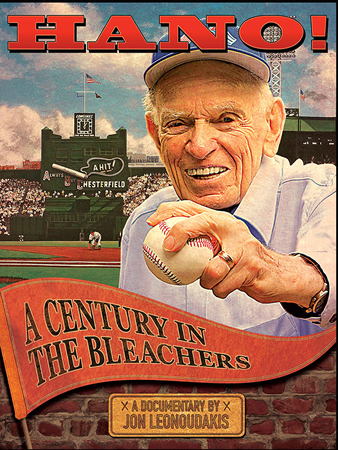In the cinema classic, “Field of Dreams,” James Earl Jones’ character Terence Mann recounts the importance of America’s national pastime to Ray Kinsella, played by Kevin Costner. “The one constant through all the years, Ray, has been baseball. America has rolled by like an army of steamrollers. It has been erased like a blackboard, rebuilt and erased again. But baseball has marked the time.”

Over 93 years, Laguna resident Arnold Hano has witnessed the tectonic magnitude of America’s shifts, all while watching it through the lens of baseball. “My love of the game is imprinted on me,” he said.
On Wednesday, Oct. 14, Hano’s life will be documented in a new film “Hano! A Century in the Bleachers”, produced and directed by award winning filmmaker Jon Leonoudakis, whose previous baseball films include “The Day the World Series Stopped” and “Not Exactly Cooperstown”.
“More people need to know about this man who is an American treasure,” said Leonoudakis. “In this film we present the untold story of an amazing life.”
Hano, a Laguna Beach resident since 1955, offers a vivid, colorful and anecdotal perspective that puts the encyclopedic statistics of “The Bill James Historical Baseball Abstract” in context. “Everyone thinks that Joe DiMaggio was such a fantastic center-fielder. He was great and I saw him play, but no one realizes that he averaged almost 100 fewer put-outs a season than Willie Mays,” said Hano.
It is just these kinds of insights that brought Leonoudakis to realize that he needed to get Hano in front of a camera. “It’s not just the runs, hits and errors that he can recount. When you talk to him you realize that he is such a fascinating guy who is a part of the quilt of popular American culture,” said Leonoudakis.
Born one block from the Polo Grounds, where the New York Giants played from the year of his birth in 1922, until their departure to San Francisco in 1958, Hano recalls that his grandfather took him to watch his first games there. “He took me on the streetcar the first few times, and then after that I was on my own,” said Hano. He still holds a grudge about that 1958 move, preferring a Giants loss than a win by the Los Angeles Dodgers.
In 1927 the family moved to the Bronx and close to another iconic stadium, “The House that Ruth Built.” “I spent my youth watching the Yankees and the Giants play,” Hano said. But Hano was not just an observer, “I was a gritty sandlot player, and if there was a ball, or a court or a bat, I was playing the game,” he said.
Hano played all sports, but loved and excelled at baseball, earning a spot on the Long Island University baseball squad (while on an academic scholarship), as a pitcher throwing a wicked reverse curveball. “My fastball never broke 80, but that screwball I could make dive away,” said Hano. While at Long Island, Hano also discovered a passion and skill as a writer, handling the sports news for the school’s paper.
After graduation from college at 19, Hano volunteered for the armed forces, serving for over three years from 1941 to 1944 in the field artillery in California. “My time playing sports mostly ended after I suffered crushed vertebrates in a training exercise while serving,” he said. His love of baseball though only continued, and he found the vehicle through writing and covering the sport for decades in a variety of capacities including: Sport Magazine, the New York Times and Los Angeles Times, as well as in books including his most famous “A Day in the Bleachers” his recounting of Game One of the 1954 World Series. “Still is the greatest catch I ever saw,” said Hano, referring to Willie Mays over the shoulder running catch to help secure the NY Giants’ victory over the Cleveland Indians. “Watching that in the stadium that day, Mays ran down that ball hit over 450 feet, but he knew he was going to catch it, right where it would be,” said Hano. Sixty years after the book’s publication, Hano still receives royalty checks. “Sometimes it’s enough to buy a nice dinner out,” said Hano’s wife, Bonnie. “It is such a charming book,” she said.
Making a list of the iconic moments and great players of the sport, Hano was most likely there watching or covering them: Oct. 8, 1956, Don Larsen’s perfect game in the World Series (check), Ted Williams’ pure hitting stroke (check), Sandy Koufax’s dazzling fastball and Roberto Clemente’s right field prowess (check and check).
Hano’s love of baseball might only be outdone over those years by the volume of written work he produced, over 500 newspaper and magazine articles and 27 books. “I wrote five westerns,” he said. On the list of the 27 includes “It Takes a Villager,” a look back over Hano and his family’s years in Laguna Beach, including his political and social activism. “We helped the city enact the nation’s first height ordinances to protect its integrity,” Hano said.
Hano’s social contributions also include bringing attention to the plight of Latin-American baseball players. “When I interviewed baseball greats Orlando Cepeda and Felipe Alou for the movie, they both commented that no one did more for Latin-American ballplayers in the ‘60s and ‘70s than Arnold Hano,” said Leonoudakis. That he did with perspicuous commentary, bringing attention to not only the talents of the players, but their unequal treatment and lack of representation.
Off the diamond, Hano fought mistreatment of California migrant laborers, calling out their ordeal in a story for Saga magazine, “The Burned Out Americans,” which won him the Sydney Hillman prize in 1963, the same year that he was voted sportswriter of the year by his peers. “He has writing chops and is a great journalist,” said Leonoudakis.
Hano today takes his positions on issues, especially baseball with the same force and sincerity as he did in the 1960’s. “Babe Ruth and Jackie Robinson were the two most influential players ever in baseball,” he said. “And no.” A quick-witted answer to a question before it was even asked. Should Pete Rose be in the Hall of Fame?
Now 60 years in Laguna Beach, Hano still believes in the city and its people. “This was and continues to be a great town,” he said. As for his own place in the history of Laguna Beach, part of that work will be done with the premiere of the new film. “Arnold quipped when I started the film, that he has lived too long, and done too much and I would have my hands full putting it on screen,” said Leonoudakis. “I knew though his story would make a great movie.”
Village Laguna (which Hano originally was a founding member) is hosting the 7 p.m. debut showing of Leonoudakis’ film at Seven Degrees, 891 Laguna Canyon Road, at no charge.
And to quote Terence Mann if he were speaking to Hano and Leonoudakis about the film… “People will come. People will most definitely come.”
For more information visit: hanodoc.com
Correction: The story “Arnold Hano Film Hits Home Run,” in the Oct. 9 edition included two inaccuracies. The story incorrectly reported that Arnold Hano’s grandfather took him on a streetcar to the Polo Grounds stadium. The article also misstated Hano’s military service; he served from 1941-44.




